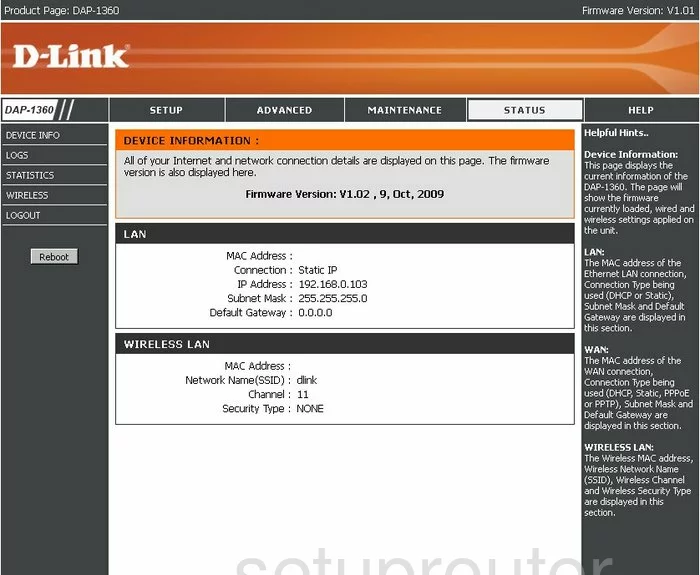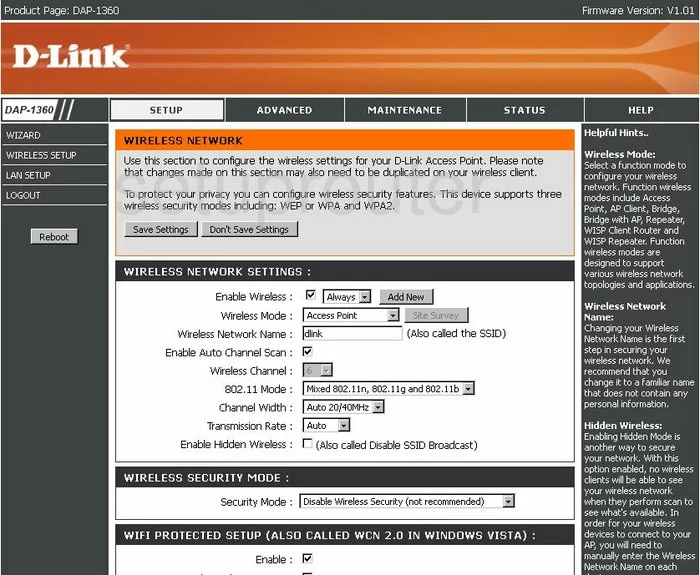The Dlink DAP-1360 router is considered a wireless router because it offers WiFi connectivity. WiFi, or simply wireless, allows you to connect various devices to your router, such as wireless printers, smart televisions, and WiFi enabled smartphones.
Other Dlink DAP-1360 Guides
This is the wifi guide for the Dlink DAP-1360. We also have the following guides for the same router:
- Dlink DAP-1360 - How to change the IP Address on a Dlink DAP-1360 router
- Dlink DAP-1360 - Dlink DAP-1360 Login Instructions
- Dlink DAP-1360 - Dlink DAP-1360 User Manual
- Dlink DAP-1360 - How to Reset the Dlink DAP-1360
- Dlink DAP-1360 - Dlink DAP-1360 Screenshots
- Dlink DAP-1360 - Information About the Dlink DAP-1360 Router
WiFi Terms
Before we get started there is a little bit of background info that you should be familiar with.
Wireless Name
Your wireless network needs to have a name to uniquely identify it from other wireless networks. If you are not sure what this means we have a guide explaining what a wireless name is that you can read for more information.
Wireless Password
An important part of securing your wireless network is choosing a strong password.
Wireless Channel
Picking a WiFi channel is not always a simple task. Be sure to read about WiFi channels before making the choice.
Encryption
You should almost definitely pick WPA2 for your networks encryption. If you are unsure, be sure to read our WEP vs WPA guide first.
Login To The Dlink DAP-1360
To get started configuring the Dlink DAP-1360 WiFi settings you need to login to your router. If you are already logged in you can skip this step.
To login to the Dlink DAP-1360, follow our Dlink DAP-1360 Login Guide.
Find the WiFi Settings on the Dlink DAP-1360
If you followed our login guide above then you should see this screen.

This guide begins on the DEVICE INFORMATION page of the Dlink DAP-1360 router. To configure the WiFi settings, first click the choice at the top of the page labeled SETUP. Then, in the left sidebar click WIRELESS SETUP.
Change the WiFi Settings on the Dlink DAP-1360

You may, at this point, be directed to a page that has several options, one of them titled Manual Wireless Network Setup. Click this option, it should be in about the middle of the screen.
The page you see above is the page you should end up on. First, find the Wireless Network Name. This is the name you give your local network so you can find it again later when needed. Create a unique name here, but avoid personal information. To learn more about this topic, read our Wireless Names Guide.
Now find the Wireless Channel drop down menu. Be sure you are on channel 1,6, or 11. These three channels are the most you can get out of the wireless spectrum without overlapping each other. Overlap causes a lot of interference. Completely sharing a channel, on the other hand, does not due to channel sharing software built into the router itself. To learn more about this topic, read our WiFi Channels Guide.
Scroll down the page a little farther and find the box labeled Security Mode. The best option here is Enable WPA2 Wireless Security (enhanced). To learn why this is the best option for your security needs, read our WEP vs. WPA Guide.
Next is the Cipher Type. This is asking how you plan on encrypting the data you send over the airwaves. Our recommendation is the use of AES. This is the most secure option for home networks.
After that you have the PSK/EAP. This should be set to Personal.
Finally, you should come to the Passphrase. This is the password you plan on using to grant access to your network. This password should be quite strong to keep hackers out. We recommend at least 20 characters. Don't use personal information here. You should also avoid any real words. To learn how to create a strong and memorable password, read our guide titled Choosing a Strong Password.
That's it, just click the Save Settings button at the top of the screen and you are finished.
Possible Problems when Changing your WiFi Settings
After making these changes to your router you will almost definitely have to reconnect any previously connected devices. This is usually done at the device itself and not at your computer.
Other Dlink DAP-1360 Info
Don't forget about our other Dlink DAP-1360 info that you might be interested in.
This is the wifi guide for the Dlink DAP-1360. We also have the following guides for the same router:
- Dlink DAP-1360 - How to change the IP Address on a Dlink DAP-1360 router
- Dlink DAP-1360 - Dlink DAP-1360 Login Instructions
- Dlink DAP-1360 - Dlink DAP-1360 User Manual
- Dlink DAP-1360 - How to Reset the Dlink DAP-1360
- Dlink DAP-1360 - Dlink DAP-1360 Screenshots
- Dlink DAP-1360 - Information About the Dlink DAP-1360 Router